What to wear in Vietnam greatly depends on the diverse climate experienced across regions and seasons. This guide delves into the importance of choosing appropriate clothing for comfort and cultural respect. Whether navigating Hanoi’s historical streets or venturing into the enchanting Mekong Delta, a thorough understanding of the climate is essential.
Contents
What to Wear in Northen Vietnam
Traveling to Northern Vietnam offers a diverse climate experience, with four distinct seasons – Spring, Summer, Autumn, and Winter. Being well-prepared in terms of clothing is crucial for a perfect journey. Let’s explore the appropriate clothing considerations for each season in this enchanting region.
- Winter in Northern Vietnam (December, January, February): Northern Vietnam experiences a cold and dry winter from December to February. Temperature can drop as low as 5 degrees Celsius, and in high mountainous areas like Sapa, it may even go below 0. Proper layering is essential, including thick, warm sweaters and fleece. Adding a life jacket and stomach shirts outside provides extra warmth. Don’t forget moisturizer and stay hydrated to prevent chapped skin.
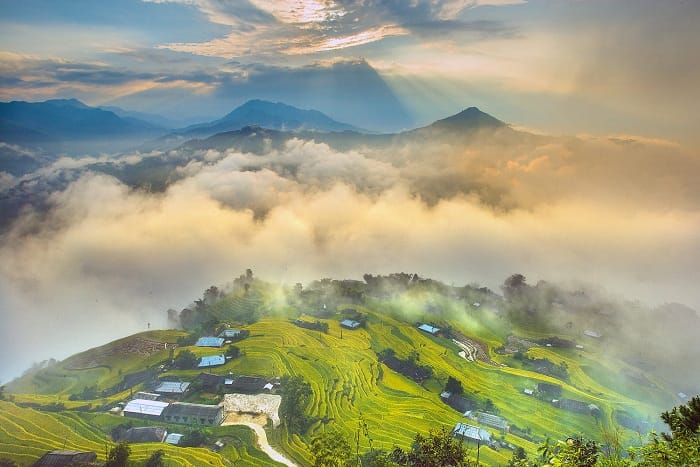
Nothern Vietnam in Winter – Source: Collected - Spring in Northern Vietnam (March, April, May): Transitioning to Hotter and Humid Weather. Spring, from March to May, signifies a transition from winter to warmer temperatures. At the beginning of the season, the weather is slightly chilly with temperatures ranging from 16-20 degrees Celsius, often accompanied by drizzle. Bring a warm blanket, a thin jacket, an umbrella, and a raincoat for drizzly days.
- Summer in Northern Vietnam (May, June, July): Summer in the North, from May to July, is characterized by intense sunshine, occasional showers, and Laotian winds. Choose light, airy fabrics that absorb sweat well. Opt for soft and bright colors to reflect sunlight. Essential accessories include umbrellas, sunglasses, sunscreen, and wide-brimmed hats for sun protection.
- Autumn in Northern Vietnam (August, September, October): Autumn, lasting from August to October, offers the best weather for travel in Northern Vietnam. The air is cool with golden sunshine, but evenings can get chilly. Light, long-sleeved clothing is appropriate. Despite the pleasant weather, prepare sunscreen and moisturizer to stay comfortable in the dry conditions.
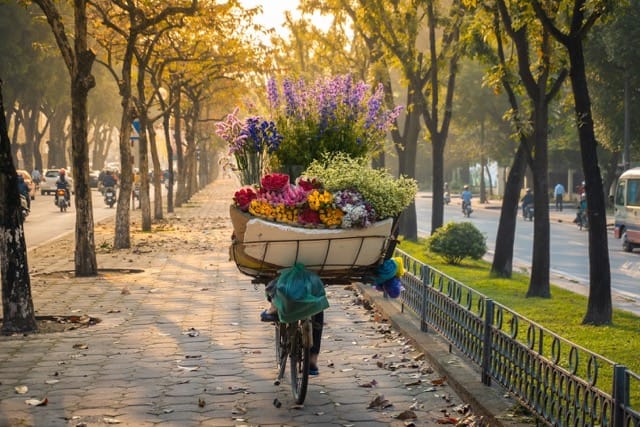
Autumn is Ideal Time to Visit Hanoi – Source: Collected
What to Wear in Central Vietnam (Hue, Da Nang, Hoi An,…)
Central Vietnam, home to the vibrant cities of Hue, Da Nang, and Hoi An, offers a rich cultural tapestry and diverse landscapes.
Summer in Central Vietnam (June, July, August):
- Central Vietnam experiences intense summer heat from June to August, marked by high temperatures and occasional monsoons. To cope with the scorching sun, pack light, airy fabrics that absorb sweat well. Soft, bright colors are ideal, reflecting sunlight and keeping you cool. Essential accessories include umbrellas, sunglasses, sunscreen, and wide-brimmed hats for sun protection.
- Central Vietnam boasts historical gems like the Imperial City of Hue and the ancient town of Hoi An. When exploring these sites during the summer, choose comfortable, breathable clothing. Loose-fitting pants or skirts paired with light tops will keep you cool. Don’t forget comfortable walking shoes as you traverse the fascinating historical landscapes.
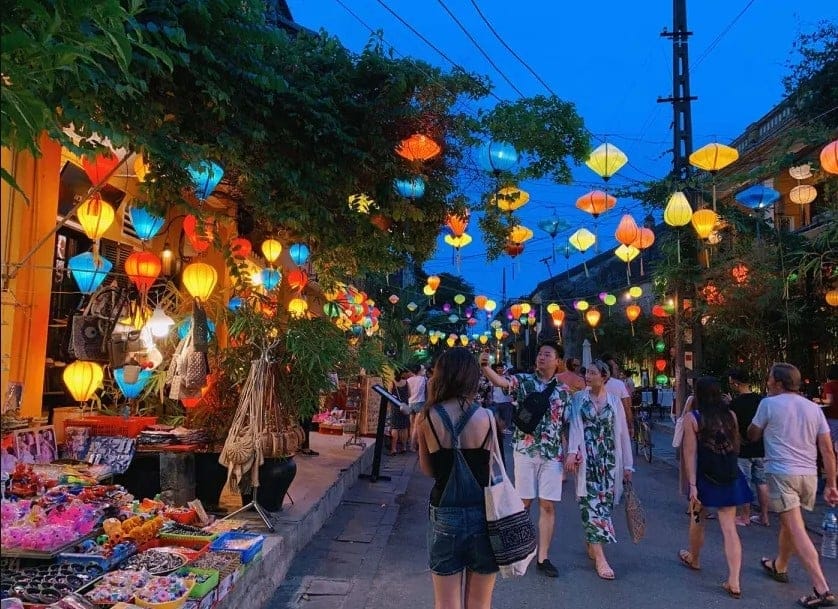
Fall in Central Vietnam (September, October, November)
- As fall sets in from September to November, Central Vietnam experiences a transition to cooler temperatures. Evenings can get chilly, so pack light jackets or sweaters for added warmth. Long-sleeved shirts and pants are suitable for the moderate temperatures during the day. It’s a perfect time to explore the cultural richness of the region without the intense summer heat.
- Fall in Central Vietnam brings vibrant cultural festivals. During this time, clothing choices can be influenced by the festive atmosphere. When attending events like the Mid-Autumn Festival in Hoi An or the Thua Thien-Hue Festival, consider wearing traditional ao dai or clothing that complements the celebratory spirit. Embrace the rich cultural traditions with your attire, respecting the significance of each festival.
Exploring Southern Vietnam: A Wardrobe Guide for Every Season
Southern Vietnam, encompassing bustling Ho Chi Minh City, the tranquil beauty of Phu Quoc, and the picturesque Mekong Delta provinces, offers a rich tapestry of landscapes and cultures.
Dry Season in Southern Vietnam (December to April)
- The dry season, spanning from December to April, is characterized by hot and dry weather in Southern Vietnam. With temperatures often reaching 30°C, it’s essential to choose clothing that keeps you cool and comfortable. Here are some wardrobe tips for urban exploration during the dry season:
- In the urban landscapes of Ho Chi Minh City and other southern cities, lightweight and breathable fabrics are your best companions. Opt for loose-fitting t-shirts, cotton clothing, and a mix of long pants and shorts to adapt to varying temperatures throughout the day. Dressing in layers allows you to adjust to the heat while ensuring comfort in air-conditioned spaces.
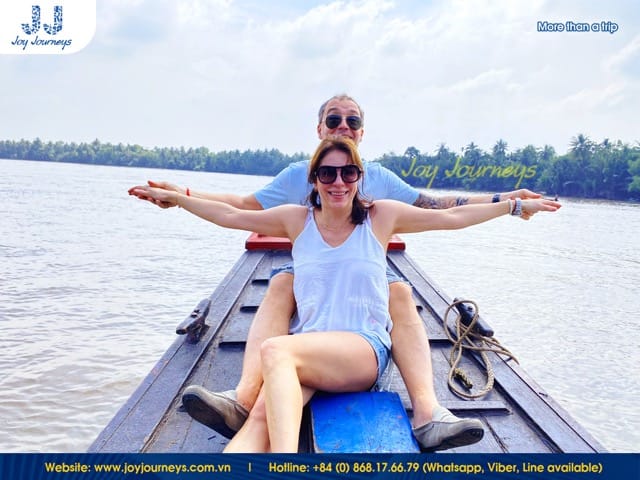
Wearing Light Clothes in Mekong Delta Tour - Pair your ensemble with comfortable footwear suitable for walking as you explore the vibrant streets, markets, and historical sites. Slippers or breathable shoes are ideal for keeping your feet cool in the warm climate. Don’t forget to accessorize with sunglasses and a hat to shield yourself from the strong sun.
Rainy Season in Southern Vietnam (May to November)
- The rainy season in Southern Vietnam, spanning from May to November, brings monsoons and higher humidity. It’s crucial to be well-prepared for sudden downpours and adjust your wardrobe accordingly. Here’s a guide to clothing choices for outdoor activities during the rainy season.
- As rain becomes a regular companion, choose quick-drying and water-resistant fabrics to stay comfortable. Lightweight rain shirts, packable rain jackets, or travel umbrellas are valuable additions to your wardrobe during this season. Be mindful of avoiding clothes made from wool as they take longer to dry, potentially leading to discomfort.

Preparing Rain Coat in the Rainy Season – Source: Collected - For outdoor excursions to places like the Mekong Delta, consider clothing that provides coverage to protect against both rain and potential sun exposure. Long sleeves and pants made of quick-drying materials offer versatility for changing weather conditions.
- Footwear plays a crucial role during the rainy season. Opt for waterproof or water-resistant shoes to keep your feet dry when navigating wet streets or participating in outdoor activities. If you plan to explore rural areas or participate in water-based activities, consider bringing water-resistant sandals.
- Accessorize with a compact, waterproof bag to safeguard your belongings from unexpected rain. Embrace the opportunity to capture the lush landscapes and vibrant scenes of the rainy season by bringing a waterproof camera or using protective gear for your electronic devices.
General Tips for Wardrobe Versatility in Southern Vietnam
- Layering is Key: Regardless of the season, layering allows you to adapt to the changing temperatures, whether you’re exploring the urban landscapes or the natural beauty of the Mekong Delta.
- Sun Protection: In both seasons, prioritize sun protection. Sunglasses, hats, and sunscreen are essential to shield yourself from the intense southern sun.
- Versatile Footwear: Choose comfortable, versatile footwear suitable for both urban exploration and outdoor adventures. From breathable shoes for city walks to water-resistant options for rainy excursions, having versatile footwear is essential.
- Cultural Considerations: When visiting temples or cultural sites, it’s important to dress modestly. Ensure your clothing covers shoulders and knees to respect local customs.
- Quick-Drying Fabrics: In the rainy season, prioritize clothing made from quick-drying fabrics to stay comfortable in unpredictable weather.
What to Wear in Vietnam: Clothing Tips for Every Occasion
Vietnam, with its rich cultural tapestry and diverse landscapes, offers a multitude of experiences for travelers.
Exploring Towns and Historical Sites
- City Cycling or Markets: For urban explorations, especially when cycling around city streets or exploring bustling markets, prioritize comfort and convenience. Choose neat and comfortable clothes that enable easy movement. Tying your hair high ensures a hassle-free experience, allowing you to navigate the city, eat, and drink comfortably without entanglements.
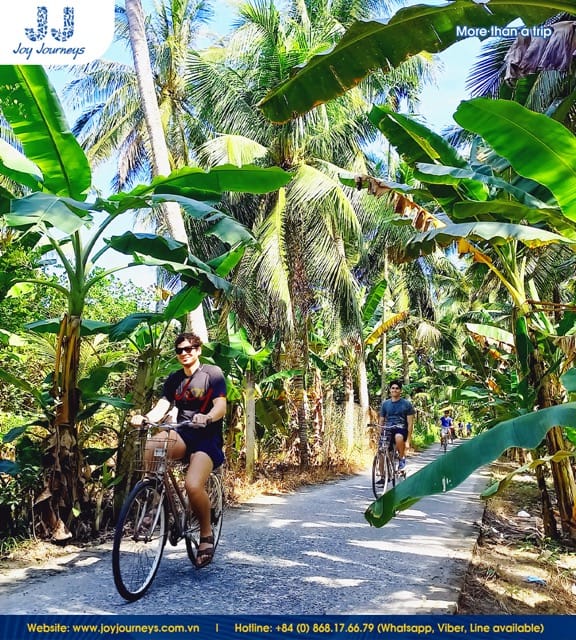
Wearing Sandals Would Be Great For Cycling - Evening Beach Strolls: For a leisurely evening stroll along Vietnam’s beautiful beaches, bring along a thin jacket to ward off the chill as the sun sets. Enjoy the gentle ocean breeze while staying comfortably warm. This simple addition to your ensemble ensures you can relish the beach atmosphere without being affected by the cooler evening temperatures.
- Dressing Appropriately for Temples and Pagodas: When visiting temples and pagodas, modesty is paramount. Prioritize historical and discreet costumes to show respect for the sanctity of these sacred places. Avoid flashy or revealing clothing to maintain the solemnity of the environment.
- Opting for ao dai or traditional Vietnamese clothing provides an excellent way to showcase both your figure and reverence for the ancient atmosphere of the temple. Choose fabrics that are not too thin to maintain modesty and cultural respect.

You Can Try Ao Dai on in Festivals – Source: Collected
Vietnamese shirts, including the ao dai nam for men and the ao dai for women, are beautiful and culturally significant garments in Vietnam.
Clothing Essentials for Climbing Adventures
- For climbing adventures, prioritize comfort with highly elastic and sweat-absorbent clothing. Avoid skirts to prevent hindrances during the climb. Choose attire that allows easy movement and adapts to changing conditions.
- Opt for comfortable sports shoes with good grip to navigate various terrains. As temperatures drop with elevation, bring a jacket to stay warm during higher altitudes.
- Carry specialized items such as climbing sticks, elbow pads, knee pads, hats, raincoats, and mosquito repellent to enhance comfort during climbing adventures. These accessories ensure a more enjoyable and comfortable climbing experience.
Specific Clothing Recommendations
- Explore the beauty of traditional Vietnamese clothing, such as the elegant ao dai, and learn how to seamlessly blend traditional styles with modern fashion.
- Discover the art of blending in with local customs while staying comfortable, allowing you to fully immerse yourself in the rich cultural experiences Vietnam has to offer.
Conclusion
In conclusion, mastering what to wear in Vietnam amplifies your travel experience, blending comfort with cultural respect. Whether navigating ancient towns, basking on beaches, or exploring sacred sites, thoughtful attire unlocks the essence of each locale. Elevate your journey by seamlessly blending traditional and modern styles, ensuring every step aligns with the rich tapestry of Vietnam’s diverse landscapes and cultural heritage.
Frequently Asked Questions
What should tourists wear in Vietnam?
General guidelines recommend lightweight, breathable clothing, considering the diverse climates. Modesty is key in certain regions, and cultural respect should guide attire choices.
Is it OK to wear shorts in Vietnam?
Yes, wearing shorts is generally acceptable, especially in casual settings. However, cultural context should be considered, and modest styles are recommended.
Is it OK to wear black in Vietnam?
Absolutely, there’s no taboo against wearing black. To blend tastefully with local fashion, incorporate black into your wardrobe while respecting modern trends.
What shoes to wear in Vietnam?
Prioritize comfortable and versatile footwear suitable for walking and exploring. Choose footwear based on specific activities and terrains to ensure a comfortable journey.


Related Posts
Saigon’s “Flower Market Replica”: Where To Find Them
Ho Chi Minh City’s floral charm is not limited to its bustling wholesale markets. Imagine wandering through a place where vibrant petals, fragrant blooms, and the spirit of traditional Vietnamese markets come alive—without the overwhelming crowds. A flower market replica captures that magic, blending the beauty of fresh flowers with the charm of a curated, […]
Is it Safe to Travel to Vietnam Right Now? A Complete 2025 Guide
Vietnam has emerged as one of Southeast Asia’s most captivating destinations, drawing millions of visitors annually with its rich culture, stunning landscapes, and incredible cuisine. However, many travelers still ask: Is it safe to travel to Vietnam right now? This comprehensive guide provides you with everything you need to know about Vietnam travel safety in […]
Ho Chi Minh Cu Chi Tunnels Tour: The Ultimate Guide
The Cu Chi Tunnels stand as one of Vietnam’s most remarkable historical sites, offering visitors a profound glimpse into the ingenuity and resilience displayed during the Vietnam War. For travelers, a Ho Chi Minh Cu Chi tunnels tour represents an essential experience that combines education, adventure, and deep cultural understanding. This comprehensive guide will help […]